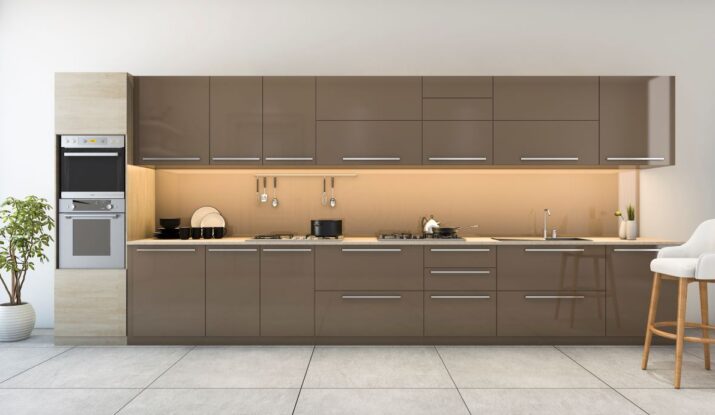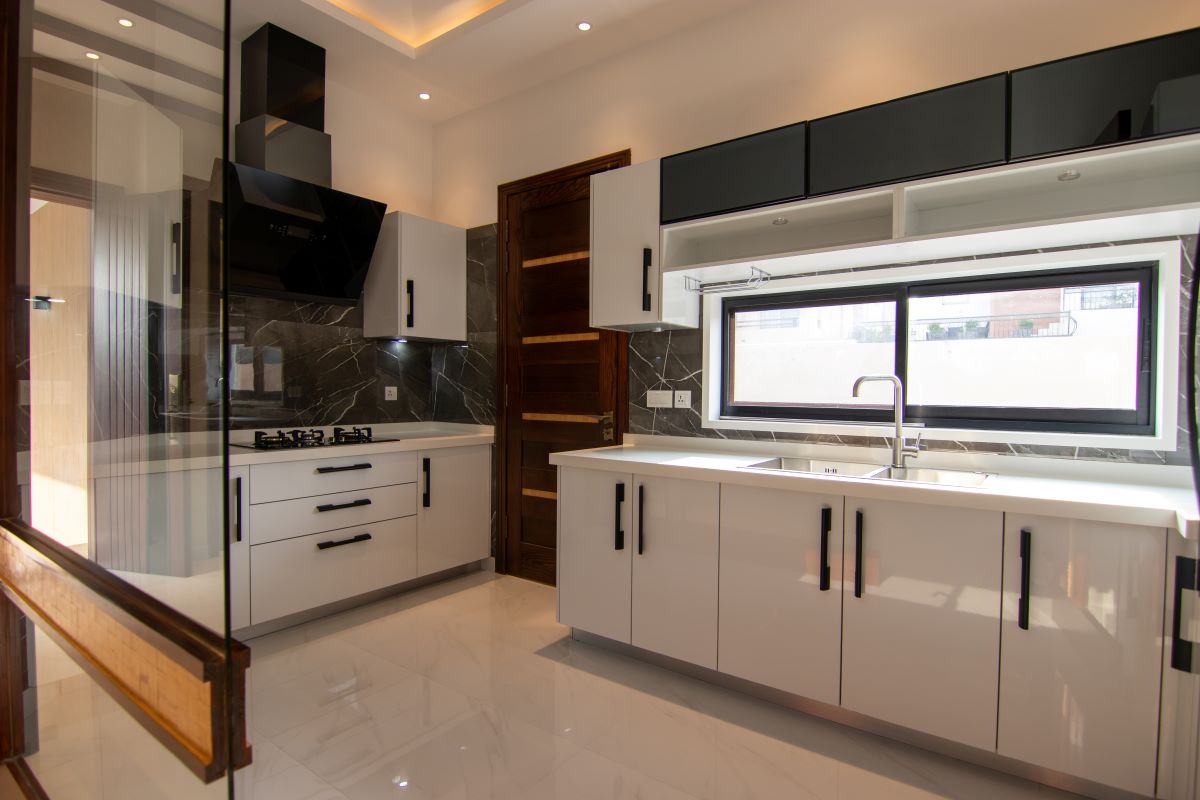When you are considering a kitchen remodel, or just need to give it a new feel, one of the questions may be, can you move kitchen cabinets? It may be the reuse of existing cabinets, redistribution of a new layout, or modernization of a fitted kitchen. But the relocation of the kitchen cupboard can be done, as long as it is perfect.
This guide explores everything you need to know before you get started. They include how to remove and reinstall wall cabinets, tips to avoid impairing cabinets, and what tools you need like a pry bar and screwdrivers. We’ll also share advice on handling overlay countertops, cabinet gates, and repositioning upper cabinets. We will also go through intelligent layouts, precautionary measures, and times to seek a professional like Dr. Cabinet.
Want to do a kitchen remodel without turning it into a nightmare? Let’s get into the basics of how to move your kitchen cupboards with safety.
Can You Move Kitchen Cabinets Without Damage?
Well, can you move kitchen cabinets without harm? The cabinets are attached on wall studs using intensive screws. When being too strong then there is always a risk of damaging cabinets, ripping off the cabinet gates or cracking the wood. With a crowbar, strap units off the wall, and carry upper cabinets upward and have somebody hold them below. Also remember to cover the countertops when doing it.
Inspect Cabinet Construction First: Tighten screws and reinforce weak corners before removal. Look under the shelf bottoms and inside drawers to spot hidden issues. Early repairs save headaches later.
Prepare the Workspace Thoroughly: Clear the room of small appliances and cover countertops with cardboard. Mark stud positions with painter’s tape so you know where weight bears. Good prep speeds the job and cuts risk of damaging cabinets or scratching finishes.
Use the Correct Tools Every Time: Keep a bucket for screws and a marker to label doors. The right gear saves time and prevents slips that dent wood or split face frames.
Reusing Existing Cabinets in a New Layout
It is clever and economical to reuse the existing cabinets in a new design. Measure and draw a layout of your kitchen, you can seek consultation from Dr. Cabinet. It will be handy to be rather precise if you’ve an old house to renovate or you’re redesigning a galley kitchen. Can you move kitchen cabinets? Yes, but first check if the cabinets will align properly in the new location to ensure a smooth fit and finish.
Mind it, base cabinets have to go down level on the floor and that wall cabinets must be fastened to studs. Mark out electrical outlets, gas pipes, or water pipes in case you are doing some construction near them, and consult with a pro just in case.
Plan Around Appliances and Door Swing: Map fridge, stove, and sink first, then slide cabinets into open gaps. Check the door sway so cabinet doors don’t collide with appliances.
Verify Level and Plumb on Every Unit: An uneven floor or bowed wall throws lines off. Shim under lower cabinets and plane filler strips until fronts sit flush. A laser level helps to avoid crooked seams in your backsplash later.
Coordinate Hardware and Color Updates: The relocation also provides you an opportunity to interchange pulls, hinges, and even coating them with a top coat of paints. Match tie shades with your backsplash to modernise your old cabinets.
Need expert layout advice? Chat with Dr. Cabinet designers now and see your dream kitchen plan in 3D.
Best Tools to Use
Here are mthe ust-have tools for the job:
| Tool | Purpose |
| Pry bar | Gently separate cabinets from walls |
| Cordless drill | Remove and reinstall attachment screws |
| Level | Ensure cabinets are plumb and true |
| Stud finder | Locate secure points on the new partition |
| Moving straps | Reduce the pressure during heavy lifting |
| Label tape | Tag doors, shelves, and hardware bags |
These tools help with minimal damage and efficient reassembly.
Step‑by‑Step: How to Carefully Remove Kitchen Cabinets
To safely remove kitchen cupboard, follow these steps:
- Remove all kitchen items in your cabinets, drawers, and shelves.
- Disconnect the electricity supply to the electrical outlets around.
- Take out cabinets, gates, screws and shelves.
- Use a crowbar to gently detach cabinets from the wall.
- Label each unit so you can reinstall it in the right place.
- Store pieces in labeled boxes to keep track of parts.
Using a great tool like a power drill and proper hand tools will reduce your effort and risk.
Detach Trim and Backsplash First: Score silicone lines with a utility knife. Gently pry trim from the wall starting at a seam.
Protect Countertops and Floors: Tape rosin paper over stone or overlay countertops. Slide plywood sheets on the floor to keep dropped screws from denting hardwood.
Organize Hardware and Shelves: Drop every hinge screw into zip bags labeled by cabinet gates. Stack shelves with spacers so edges don’t mar.
Dealing With Laminate Countertops and Sink Areas
Laminate countertops need extra care as they’re often glued to lower cabinets. Around the sink, disconnect the plumbing and remove the sink entirely. This avoids damage and gives you full access to surrounding cabinets. Label plumbing connections and take pictures for reassembly. Replacing the overlay countertops might be easier than salvaging them.
Safely Remove the Sink Without Cracks: Loosen clips beneath the rim, then lift evenly. Support the basin with a helper. Avoid twisting that can chip edges or nick your countertops.
Handle Plumbing Lines With Care: Cap water tubes to stop drips. Photograph valve positions so reconnecting later is simple. A small bucket under lines catches residual water.
Clean Adhesive Residue Thoroughly: Use a plastic putty knife to scrape leftover glue . The new adhesive tightens in the bond with a clean base so that the top is re-bonded in its new location.
Pry Bar Types and Best Uses
| Pry Bar Type | Best For | Caution |
| Flat bar | Removing trim and molding | Slide gently to avoid gouging drywall |
| Wonder bar | Separating cabinet backs from studs | Use wood shims to protect paint finishes |
| Roofing bar | Lifting heavy lower cabinets slightly | Lift slowly to prevent cracking countertop seams |
Adjusting for a Fitted Kitchen
Moving the cookery cupboard to a new partition or fitting them into a fitted cookery requires planning. Ensure to have information about the location of your wall supports as well as whether the cabinet units will fit in the new space. Install base cabinets first and make them level and then install countertops. Then mount your upper cabinets. Leave space for backsplash and appliances. Screw in each unit twice and measure beforehand. Minor errors in a fitted kitchen layout have a potential of producing enormous gaps and unutilized space.
Check Ceiling Height and Clearance: Roomy soffits in an antique house may differ from modern ceilings. Check height so upper cabinets sit at a uniform line, preventing awkward gaps.
Secure Each Cabinet to Wall Studs Properly: Long screws into marked studs carry weight safely. Never rely on drywall alone. Add ledger boards under uppers for temporary support during install.
Align Backsplash and Countertop Heights: Make sure that countertops conclude slightly beneath backsplash tile edges.
Ready to move your cabinets without stress? Schedule a free on‑site quote with Dr. Cabinet today!
Modern heat tape protects exposed pipes in unheated spaces. Harsh winter weather reaches crawl spaces, so use heat tape and foam sleeves where low temperatures settle. Can you move kitchen cabinets? Yes, with smart planning with Dr. Cabinet.
DIY vs Professional Cabinet Move
| Aspect | DIY Approach | Professional Service |
| Cost | Low cash out, high personal labor | Higher fee, zero personal strain |
| Time | Weekends or evenings, may stretch for days | 1–2 day turnaround with crew |
| Tools | Must purchase or rent crowbars , lifts, clamps | All specialty tools included |
| Risk of Damage | Depends on skill; higher for beginners | Insured craftsmanship and minimal damage |
| Warranty | None | Workmanship guarantee from Dr. Cabinet |
| Layout Planning | DIY sketches and trial‑and‑error | Precise measurements and CAD kitchen design |
Creative Makeover Ideas
Moving during a remodel raises a big question, can you move kitchen cabinets when updating your space? Absolutely, and it gives you the chance to rethink your layout and gain more usable room and space. One smart approach is learning how to update brown kitchen cabinets without replacing them entirely. A quick facelift is possible by sanding and replacing them by putting on stylish handles. Reuse these cupboards by moving them in areas where the ceiling height is higher or next to a tall pantry as a more balanced symmetry.
To make it even more snazzy, install butcher block countertops fitted which would complement the dark wood tones. The new kitchen can be efficient and visually clean by never forgetting to declutter and store seasonal or used-less kitchen stuff to relocate cabinets or deep counters. You could even relocate attached cabinets to a laundry room or a bathroom so it would have more storage as well as a design flow. Ensure the shelves are quite secure and stable.
Common Mistakes to Avoid
Avoid these costly mistakes when moving your cookery cupboard:
- Forcing the crowbar and splitting wood. This weakens joints and shortens the life of all the cabinets.
- Skipping the labeling of parts. Missing screws delay reassembly and cause frustration.
- Forgetting to shut off water tubes. Leaks soak boxes and warp wood.
- Not checking the new layout for space. Crowded corners hinder door swing and traffic flow.
- Overloading the upper cabinets after reinstalling. Too much weight on freshly moved units leads to sagging.
Planning first is always crucial, if you want to save time, storage, and money.
Should You Hire a Professional?
A professional installer from Dr. Cabinet or an interior designer would be an intelligent decision to hire especially when it involves a complicated kitchen remodel project. They will do all the procedures of moving wall plug, putting your wall cabinets and backsplash back, with precision. They will also make sure that the cabinets are strongly attached, sit fit between the ceiling and they are also well aligned with the already available counters.
As you rearrange cabinetry to another room (e.g., a bathroom), add additional units into a pantry, or just are standing around thinking, can you move kitchen cabinets a professional can help you get the most out. They will provide a finish that presents you with more storage.
FAQs
Q1: Can you move kitchen cabinets without damage?
Yes. Use labeled bags for screws, cushion every drawer, and unfasten each box from studs with a padded pry bar. Move slowly, keep surfaces padded so frames stay square, shelves stay tight, and panels avoid splits or chips during transit.
Q2: How do you move the kitchen cupboard in a galley kitchen?
Measure aisle clearance, map door sway, remove surrounding appliances, and slide units out one by one. A galley layout demands tight turns, protect corners with cardboard, and finish by shimming bases to level while leaving walking space between counters.
Q3: What is the safest way to detach wall cabinets?
Take off cabinet doors first, unscrew mounting rails, brace bottoms with a ledger board, then lift boxes straight up. Support the weight as you back out the final screws so nothing drops.
Q4: Can I reuse laminate countertops after moving them?
Often yes. Slice caulk cleanly, separate tops with a flat pry bar, remove old adhesive, and set the slab aside on padded blocks. Inspect for swell spots; minor chips patch with color‑match filler before reinstalling in the new location.
Q5: How do you handle plumbing under the sink when relocating cabinets?
Shut water valves, unscrew supply lines, place a tub under traps, then drain and label each hose. Cap water tubes until reinstall to avoid drips, and plan new holes through backs so fittings clear without kinks.
Q6: Should I repaint my old cabinets after moving them?
Yes. Sand lightly, prime bare spots, then roll on a fresh second coat to hide scuffs from removal. New paint seals edges, modernizes color, and blends patched nail holes so the whole run looks like new cabinets.
Q7: How do I secure cabinets on a new wall with minimal damage?
Locate wall support, pre‑drill pilot holes, and drive long structural screws through sturdy rails. Check level side to side and shim gaps so fronts align, giving strong support with no crushed drywall.
Q8: Can you move kitchen cabinets in an old house without tearing the plaster?
Yes, but score paint seams first, pry slowly, and reinforce weak plaster with strips before reinstalling. Use wide putty knives behind bars to spread pressure so the surface stays intact.
Q9: What are common mistakes when reusing existing units?
Forgetting to label parts, losing small screws, skipping shims, and ignoring uneven floors. Plan ahead, keep hardware sorted in boxes, and double‑check measurements.
Q10: When should I call a pro instead of DIY?
Call when relocating load bearing walls, redirecting gas or water lines or when you want to hoist extra large pantry towers. Professional crews bring lifts, and guarantee structural safety.
Conclusion
So, can you move kitchen cabinets safely in 2025? Yes, when you combine careful planning, the right pry bar, labeled screws, and patience. Assess your existing cabinets, reinforce weak spots, and remove trim first to avoid splinters. Sketch the new layout, mind door sway, and shim bases level so countertops sit true. Reusing cabinetry saves money, keeps landfill waste low, and can even add more space when units shift into unused wall space.
Follow the detailed steps, stay organized with labeled boxes, and finish with a crisp second coat of paint. When challenges exceed your toolkit, like moving tall pantry towers in a tight galley kitchen, call the pros. Procure a second helper, and do it slowly. This guide will save you stress whether you are refurbishing an old house or thinking of kitchen remodel. Your dream kitchen layout is possible with patience and smart moves.
Tight timeline? Book Dr. Cabinet’s rapid‑install team and enjoy your refreshed kitchen sooner.





